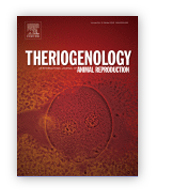Is an epidural component during general anaesthesia for caesarean section beneficial for neonatal puppies' health and vitality?
Agnieszka Antończyk, Małgorzata Ochota
Theriogenology
Ministerial score = 140.0
Journal Impact Factor (2020) = 2.740 (Q1)
 Regional centro-axial block is a recommended technique for uncomplicated caesarean section in human medicine. Since the application of regional anaesthesia as the only technique in veterinary medicine is impractical, the objective of the study was to assess and compare the epidural component of caesarean section (CS) on maternal and fetal outcomes. Bitches (n = 36) undergoing elective CS were enrolled in this study. Females were randomly assigned into two groups: Gr I (Isoflurane, n = 20) and Gr IE (Isoflurane plus Epidural, n = 16). Anaesthesia was induced with propofol, and maintained with isoflurane in oxygen. In the IE group, epidural anaesthesia was also performed using lidocaine. The maternal intraoperative parameters were compared at three time points: T1 – just before the skin incision, T2 – after the last puppy removal, and T3 – at the end of surgery. At least 100 mcl of mixed umbilical cord blood was collected for gas analysis. The modified Apgar scoring system (AS) was used to objectively score newborn health and vitality immediately after birth (0 min), 5 and 20 min after birth. Systolic, diastolic, and mean blood pressure were lower in the IE group at T1, T2, and T3 compared to I group (p < 0.05). In the combined anaesthesia group blood pressure remained stable but low at all time points. Throughout surgery, the IE group required a lower concentration of isoflurane (p < 0.05). The median values of the umbilical blood gas results were found to be similar (p > 0.05) in both investigated groups. The initial results of the Apgar score were comparable in the I and IE groups (p > 0.05). However, subsequent AS measurements revealed significant differences between both groups. Puppies from the IE group received better AS scores at 5 and 20 min compared to the I group (median AS 8 and 9 vs. 5 and 8, respectively). The results obtained demonstrated that epidural anaesthesia administration reduced the requirement for isoflurane in dams undergoing caesarean section and despite episodes of maternal hypotension did not affect the results of neonatal umbilical blood gas. Furthermore, newborns from the epidural anaesthesia group improved more quickly postnatally, developing a satisfactory condition in a shorter time.
Regional centro-axial block is a recommended technique for uncomplicated caesarean section in human medicine. Since the application of regional anaesthesia as the only technique in veterinary medicine is impractical, the objective of the study was to assess and compare the epidural component of caesarean section (CS) on maternal and fetal outcomes. Bitches (n = 36) undergoing elective CS were enrolled in this study. Females were randomly assigned into two groups: Gr I (Isoflurane, n = 20) and Gr IE (Isoflurane plus Epidural, n = 16). Anaesthesia was induced with propofol, and maintained with isoflurane in oxygen. In the IE group, epidural anaesthesia was also performed using lidocaine. The maternal intraoperative parameters were compared at three time points: T1 – just before the skin incision, T2 – after the last puppy removal, and T3 – at the end of surgery. At least 100 mcl of mixed umbilical cord blood was collected for gas analysis. The modified Apgar scoring system (AS) was used to objectively score newborn health and vitality immediately after birth (0 min), 5 and 20 min after birth. Systolic, diastolic, and mean blood pressure were lower in the IE group at T1, T2, and T3 compared to I group (p < 0.05). In the combined anaesthesia group blood pressure remained stable but low at all time points. Throughout surgery, the IE group required a lower concentration of isoflurane (p < 0.05). The median values of the umbilical blood gas results were found to be similar (p > 0.05) in both investigated groups. The initial results of the Apgar score were comparable in the I and IE groups (p > 0.05). However, subsequent AS measurements revealed significant differences between both groups. Puppies from the IE group received better AS scores at 5 and 20 min compared to the I group (median AS 8 and 9 vs. 5 and 8, respectively). The results obtained demonstrated that epidural anaesthesia administration reduced the requirement for isoflurane in dams undergoing caesarean section and despite episodes of maternal hypotension did not affect the results of neonatal umbilical blood gas. Furthermore, newborns from the epidural anaesthesia group improved more quickly postnatally, developing a satisfactory condition in a shorter time.
DOI:10.1016/j.theriogenology.2022.04.015









